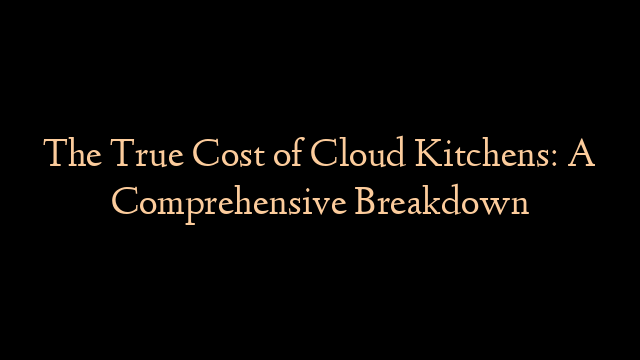Cloud kitchens, also known as ghost kitchens or virtual kitchens, have emerged as a popular business model in the food industry. They offer entrepreneurs and restaurateurs a cost-effective way to enter the market without the need for traditional brick-and-mortar establishments. However, understanding the costs involved in operating a cloud kitchen is crucial for making informed decisions and ensuring profitability. This comprehensive guide provides a breakdown of the key expenses associated with cloud kitchens, from initial investments to ongoing costs.
1. Understanding Cloud Kitchen Costs: A Comprehensive Guide
Cloud kitchen costs can vary significantly depending on factors such as location, size, and the type of cuisine offered. It is essential to carefully consider each expense category and develop a realistic budget before launching your operation.
2. Initial Investment: A Breakdown of Startup Expenses
The initial investment for a cloud kitchen typically includes:
- Rent and Security Deposit: Securing a suitable location for your kitchen.
- Kitchen Equipment: Purchasing essential appliances, such as stoves, ovens, and refrigeration units.
- Furniture and Fixtures: Equipping the kitchen with tables, chairs, and other necessary items.
- Renovations and Upgrades: Making any necessary modifications to the kitchen space.
- Legal and Licensing Fees: Obtaining permits and licenses to operate a food business.
3. Rent and Utilities: Securing a Suitable Location
Rent is a significant ongoing expense for cloud kitchens. Factors to consider include the size and location of the kitchen, as well as the availability of utilities such as electricity, gas, and water.
4. Equipment and Appliances: Essential Tools for Success
Investing in high-quality equipment is crucial for efficient and safe food preparation. This includes:
- Cooking Equipment: Stoves, ovens, grills, and fryers.
- Refrigeration and Storage: Refrigerators, freezers, and dry storage units.
- Food Preparation Equipment: Food processors, mixers, and cutting boards.
- Kitchenware: Pots, pans, utensils, and cutlery.
5. Labor Costs: Staffing and Wages for Operations
Labor costs are a major expense for cloud kitchens. This includes:
- Kitchen Staff: Chefs, cooks, and kitchen assistants.
- Delivery Drivers: For orders that require delivery.
- Management and Administrative Staff: To oversee operations and handle administrative tasks.
6. Food and Beverage Expenses: Ingredients and Packaging
The cost of ingredients and packaging will vary depending on the type of cuisine offered. Factors to consider include:
- Raw Materials: Fresh produce, meats, and dairy products.
- Prepared Ingredients: Pre-cut vegetables, sauces, and marinades.
- Packaging Materials: Containers, bags, and utensils for food delivery.
7. Marketing and Advertising: Reaching Your Target Audience
Effective marketing and advertising are essential for attracting customers to your cloud kitchen. This includes:
- Online Marketing: Website, social media, and search engine optimization (SEO).
- Offline Marketing: Flyers, posters, and local advertising.
- Partnerships and Collaborations: With food delivery platforms and local businesses.
8. Insurance and Licensing: Protecting Your Business
Adequate insurance coverage is crucial for protecting your business from potential risks. This includes:
- General Liability Insurance: Covers accidents and injuries.
- Property Insurance: Protects your kitchen and equipment.
- Workers’ Compensation Insurance: Provides coverage for employees in case of workplace injuries.
- Food Safety Licensing: Ensures compliance with food safety regulations.
9. Technology and Software: Streamlining Operations
Technology can streamline operations and improve efficiency. This includes:
- Point-of-Sale (POS) System: For order taking and payment processing.
- Inventory Management Software: For tracking inventory levels and reordering supplies.
- Delivery Management Software: For managing delivery orders and tracking drivers.
10. Delivery and Logistics: Ensuring Efficient Food Delivery
For cloud kitchens that offer delivery, efficient logistics are essential. This includes:
- Delivery Vehicles: Cars, motorcycles, or bicycles for delivering food.
- Delivery Drivers: To handle deliveries and ensure timely service.
- Delivery Management System: For tracking orders and optimizing delivery routes.
11. Overhead Expenses: Additional Costs to Consider
In addition to the major expense categories, there are various overhead expenses to consider:
- Cleaning and Maintenance: Keeping the kitchen clean and sanitary.
- Waste Disposal: Disposing of food waste and packaging materials.
- Administrative Costs: Office supplies, postage, and accounting fees.
12. Ongoing Expenses: Maintaining and Growing Your Cloud Kitchen
Once your cloud kitchen is operational, there are ongoing expenses to maintain and grow your business:
- Rent and Utilities: Ongoing monthly payments for the kitchen space.
- Equipment Maintenance and Repairs: Regular servicing and repairs to keep equipment in good working order.
- Staffing and Wages: Salaries and benefits for employees.
- Marketing and Advertising: Continuous efforts to attract new customers.
- Technology and Software Upgrades: Keeping up with the latest technology to enhance operations.
Understanding the costs involved in operating a cloud kitchen is essential for making informed decisions and ensuring financial success. By carefully considering each expense category and developing a realistic budget, you can minimize risks and maximize profitability. Remember that the cloud kitchen model offers significant cost advantages over traditional brick-and-mortar restaurants, but it is crucial to approach the business with a clear understanding of the financial implications.


